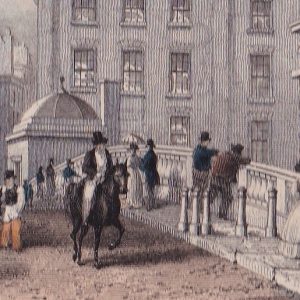The original wooden medieval bridge, built to cross the Avon in Bristol, comprised four arches, and its two sides had five storey high dwellings that jettied over the edge of the bridge. In the early eighteenth century, the City of Bristol expanded dramatically, and this entrance from the London direction became highly congested, so the Bristol MP Sir Jarrit Smyth called for the construction of a new bridge.
 The Bristol engineer and draughtsman James Bridges, successfully designed the triple arched stone replacement, but he was frequently attacked by other local architects for his inexperience, and he finally abandoned his work and left the country.
The Bristol engineer and draughtsman James Bridges, successfully designed the triple arched stone replacement, but he was frequently attacked by other local architects for his inexperience, and he finally abandoned his work and left the country.
However, after eight years of construction by Thomas Paty, the new stone bridge was finally opened in 1768, based on the classical design of Westminster Bridge in London. The two outer semi-circular arches spanned 40 feet each and the central elliptical arch had a span of 55 feet. This new bridge had stone balustrades and square toll gates at both ends, but the new toll charges proved unpopular with the locals. The continuation of a levy even after the construction costs had been completed, led in 1793 to the Bristol Bridge Riot. When the tollgates and their interiors were burnt by rioters, the militia were ordered to open fire on the crowd, killing 11 people and wounding 52.
The Georgian bridge now lays hidden under Victorian expansion work. In 1861, a width of 11 feet was added to the east side, the stone balustrade removed and a new footway added. It was further widened on the west side in 1874. The remains of the bridge are now Grade II listed.

Leave a Reply